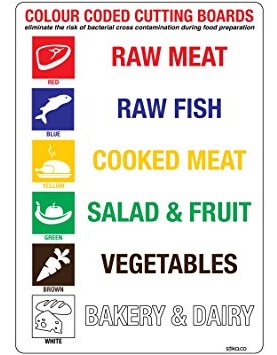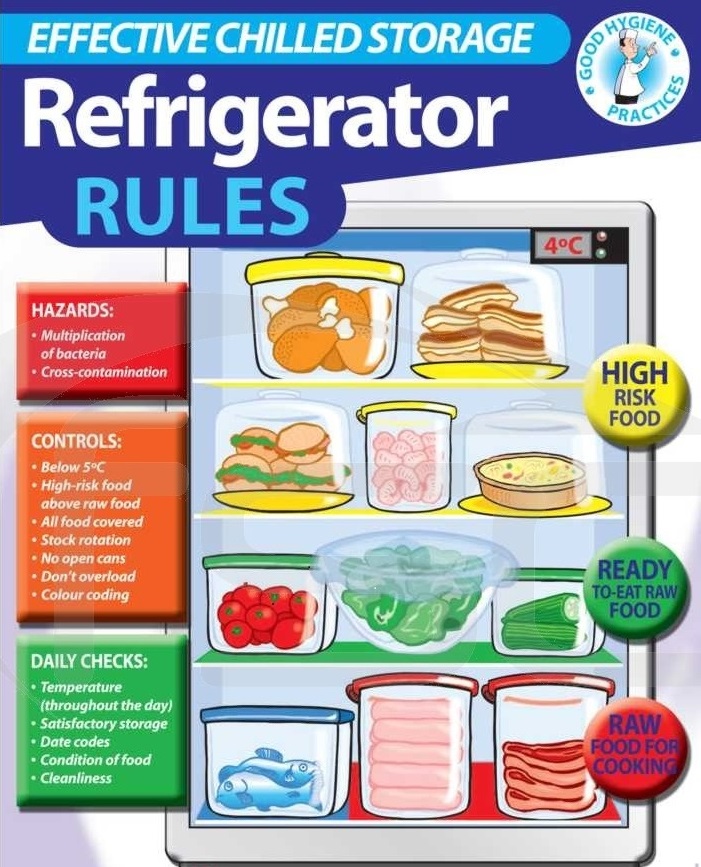Step 2 - Separate

Improper handling of raw meat, poultry, seafood and eggs can create an inviting environment for cross-contamination. Cross-contamination occurs when harmful germs from raw foods or contaminated surfaces are passed onto other food. As a result, harmful bacteria can spread to food, utensils, surfaces and throughout the kitchen.
CROSS-CONTAMINATION:
Cross - contamination or the transfer of germs from raw foods to other surfaces may occur in any of the following situations:
- When hands that have touched raw food touch foods that are ready to eat.
- When raw or contaminated food touch foods that are ready to eat.
- When a ready to eat food comes into contact with surfaces that were not properly washed and sanitized after having been in contact with a raw food. Food contact surfaces include cutting boards, knives, utensils, and food preparation tables.
- When dirty wiping cloths or wiping cloths contaminated with raw foods are used on surfaces that come into contact with ready to eat foods.
Cross-contamination can be prevented by washing and sanitizing every utensil, cutting board, food preparation table, and work area before and after coming in contact with food. Use the cleaning/sanitizing methods previously mentioned and adequately wash you hands, especially after handling raw foods.
SEPARATE RAW MEAT, POULTRY, SEAFOOD AND EGGS FROM OTHER FOODS:
Harmful bacteria from raw meat, poultry, seafood and eggs can spread to other foods if they are not separated properly. This is especially risky when bacteria are spread to foods that are eaten raw, such as fresh fruits and vegetables. Separate and prevent cross-contamination by taking these steps.
In the grocery store:
- Separate raw meat, poultry, seafood and eggs from other foods in your shopping cart.
- Place these products in separate plastic bags to prevent juices from getting on other foods.
- If you use reusable grocery bags, wash them frequently in the washing machine.
At school:
- Separate raw meat, poultry, seafood and eggs from other foods in the refrigerator.
- Place them in containers or sealed plastic bags on the bottom shelf of the refrigerator to prevent their juices, which may contain harmful bacteria, from dripping onto other food.
- If you are not planning to use these foods within a few days, freeze them.
- Do not store food items directly on the floor or in plastic container or tubs directly on the floor. Ensure all foods that do not require refrigeration are stored at least 6 inches off the floor.
SEPARATE CUTTING BOARDS, PLATES AND UTENSILS:

Cutting Boards: Use separate cutting boards when preparing raw meats, one for fresh produce and a separate board for raw meat, poultry and seafood. Meats can be further separated by using a color coded cutting board system for different cuts of meat. See the image to the right.
Plates/Utensils: Use separate plates and utensils for cooked and raw foods. Never place cooked food back on a plate that previously held raw meat, poultry, seafood or eggs. Clean and sanitize the plate before using with other foods.
Safely Marinate: Sauce that is used to marinate raw meat, poultry or seafood should not be used on cooked food unless it is boiled first to destroy any harmful bacteria. Always marinate food in the refrigerator, not on the counter. Use food-grade plastic, stainless steel or glass containers. Never reuse marinades for other foods.
Reminder: Wash Hands! Washing hands with soap and warm water before and after handling raw food is the best way to reduce the spread of germs that can make you sick.
REFRIGERATION:

- Ensure your refrigerator is set to 4°C and the freezer is -18°C. All school refrigerators have had new thermometers placed in them in 2017. If your thermometer is missing/broken, please contact the divisional safety officer.
- Refrigerate or freeze perishables, prepared foods and leftovers immediately after shopping or preparing.
- Place raw meat, poultry and seafood in containers in the refrigerator, to prevent their juices from dripping on other foods. Store on shelves below ready-to-eat foods or on the bottom shelf of the refrigerator, as raw meat juices contain harmful bacteria.
- Buy cold foods last. If the destination is farther away than 30 minutes, bring a cooler with ice or freezer gel pack and pace perishables in it.
- Do not store food in open tins or boxes.
- Do not store hot foods in the refrigerator.
- Do not over pack the refrigerator. Arrange food to allow for good air circulation.
- Store strong smelling food in a suitable airtight container.
- Store raw meats below other food or on the bottom of the refrigerator.
- Refrigerator Rules
FOOD STORAGE LIMITS AND APPROVED FOODS:
- Foods should always be used in the same order in which they were received. All arriving food products should be marked with a date so you know which inventory to use first.
- Any ready-to-eat potentially hazardous food should be marked with a discard date at the time of opening or preparation. The discard date must not be > 7 days after the food was prepared or opened, if the food has been refrigerated at 4°C or less and < 4 days if refrigeration did not occur with in a safe time limit (2 hrs or more).
- Home made foods can not be used or offered for sale at school.
- All packaged food must carry a label or seal on the packaging that indicates the name of the processor or distributor, the name of the food, and the ingredients.
- All foods arriving at your workplace must be free of spoilage.
- Canned foods must have an intact seal and be discarded if swollen.
- Potentially hazardous foods should be rejected if they arrive at an unsafe temperature.
- All chemicals, lotions, detergents, medicines, sanitizers, and cleaners must be stored away from food, utensils, and food preparation areas. Any chemical product that is not in its original container must be clearly labeled as to its contents.
- Refrigerator Storage Chart


Please provide your question and email address in the fields below.
Your question has been successfully submitted.
CloseThank you.